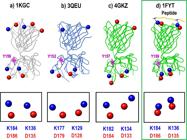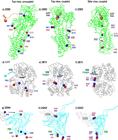Abstract
The coupling of a ligand with a molecular receptor induces a signal that travels through the receptor, reaching the internal domain and triggering a response cascade. In previous work on T-cell receptors and their coupling with foreign antigens, we observed the presence of planar molecular patterns able to generate electromagnetic fields within the proteins. These planes showed a coherent (synchronized) behavior, replicating immediately in the intracellular domain that which occurred in the extracellular domain as the ligand was coupled. In the present study, we examined this molecular transduction - the capacity of the coupling signal to penetrate deep inside the receptor molecule and induce a response. We verified the presence of synchronized behavior in diverse receptor-ligand systems. To appreciate this diversity, we present four biochemically different systems - TCR-peptide, calcium pump-ADP, haemoglobin-oxygen, and gp120-CD4 viral coupling. The confirmation of synchronized molecular transduction in each of these systems suggests that the proposed mechanism would occur in all biochemical receptor-ligand systems.
Keywords:
cell signaling; molecular coupling; molecular patterns; quantum coherence; structure-function relationship

 Thumbnail
Thumbnail
 Thumbnail
Thumbnail
 Thumbnail
Thumbnail


